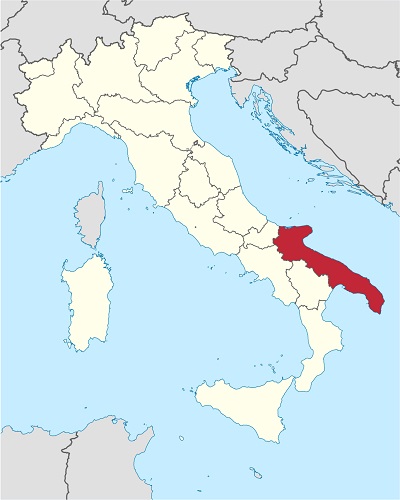Nero di Troia (Italy)
Nero di Troia (aka Uva di Troia) is a red wine grape from Puglia.
Nero di Troia Flavors
Cherry, Dark Berries, and Plums are typical Nero di Troia flavors.
Hints of Olive, Sweet Spices, and Licorice.
Red Cherry |
Black Cherry |
Blackberry |
Black Currant |
Plum |
Violets |
Sweet Spices |
Licorice |
Flavors from Maturation and Aging
Vanilla |
Chocolate |
Tobacco |
Leather |
Nero di Troia Profile
Nero di Troia tends to have a fruity budy, nice tannins and medium acidity:
| SUGAR: | Dry (3 g/l) |
| BODY: | Medium - Full |
| TANNINS: | Medium - Plus |
| FRUIT: | Medium - High |
| ACIDITY: | Medium |
| ALCOHOL: | 13-14% ABV |
| Serving temperature: 17-18°C (63-64°F) | |
Nero di Troia Food Pairing
Nero di Troia pairs best with Roasted or Grilled Meat, Game, and Rich Pasta.
Cured Meat |
Salami |
Rich Pasta |
Lasagna |
Chicken |
Pork |
Lamb |
Rabbit |
Wild Boar |
Deer |
BBQ |
Cheese |
Excellent Pairings
Cured Meat. Salami.
Rich Pasta. Spaghetti. Lasagne.
Grilled Chicken or Pork.
BBQ. Roasted Lamb.
Game. Rabbit. Wild Boar. Deer.
Puglian Specialities
Ragù alla Pugliese (Meat Stew).
The Ideal Glass for Nero di Troia
The Bordeaux Glass was designed for enjoying fuller-bodied, tannic red wines.

|
They are taller than other red wine glasses, and has a slimmer bowl.
The slimmer bowl directs the wine to the back of your mouth for a maximum taste. The size also allows the bouquet of the wine to develop, smooth out rough edges, play down tannins, and allow the wine to achieve balance. |
If You Like Nero di Troia
You Might Also Like:
Nero di Troia DOC(G)
Castel del Monte Nero di Troia Riserva DOCG (2011):
- Minimum 90% Nero di Troia
- Alcohol: Minimum 13.0%
- Sugar: Maximum 10 g/l (1.0%)
- Aging: Minimum 2 years. 1 year in barrel
(Earlier a part of Castel del Monte DOC)
Castel del Monte Rosso Riserva DOCG (2011)
- Minimum 65 Nero di Troia
- Alcohol: Minimum 13.0%
- Sugar: Maximum 10 g/l (1.0%)
- Aging: Minimum 2 years. 1 year in barrel
(Earlier a part of Castel del Monte DOC)
Nero di Troia is the main grape in the following DOCs:
- Castel del Monte DOC (Minimum 90%)
- Barletta DOC (Minimum 70%)
- San Severo DOC (Minimum 70%)
- Talvoliere DOC (Minimum 65%)
- Rosso di Cerignola DOC (Minimum 55%)
Region Puglia (Apulia)

Climate
Puglia has a predominantly Mediterranean climate with hot, dry summers and mild, wet winters. The region's flat plains, rolling hills, and proximity to the Adriatic and Ionian Seas contribute to a variety of microclimates.
The warmth and abundance of sunlight make Puglia well-suited for grape cultivation.
Black Grapes |
White Grapes |

15% Primitivo |

13% Trebbiano |
Red Wines |
White Wines |

Aglianico |

Rosé Wines: |

Denominations
Castel del Monte Bombino Nero DOCGCastel del Monte Nero di Troia Riserva DOCG
Primitivo di Manduria Dolce Naturale DOCG
Aleatico di Puglia DOC
Alezio DOC
Barletta DOC
Brindisi DOC
Cacc’è Mmitte di Lucera DOC
Castel del Monte DOC
Castel del Monte Rosso Riserva DOCG
Colline Joniche Tarantine DOC
Copertino DOC
Galatina DOC
Gioia del Colle DOC
Gravina DOC
Leverano DOC
Lizzano DOC
Locorotondo DOC
Martina / Martina Franca DOC
Matino DOC
Moscato di Trani DOC
Nardò DOC
Negroamaro di Terra d’Otranto DOC
Orta Nova DOC
Ostuni DOC
Primitivo di Manduria DOC
Rosso di Cerignola DOC
Salice Salentino DOC
San Severo DOC
Squinzano DOC
Tavoliere delle Puglie / Tavoliere DOC
Terra d’Otranto DOC







